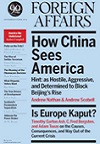In contrast to its Cold War strategy of containment, Washington’s current approach to China is not the product of a deliberate planning process. It is nowhere codified in official documents. Indeed, it does not even have a name. Still, for the better part of two decades, the United States has pursued a broadly consistent two-pronged strategy combining engagement and balancing.
U.S. presidents from Richard Nixon to Barack Obama have worked to engage China through diplomacy, trade, scientific cooperation, and educational and cultural exchange. Since the mid-1990s, successive administrations have also taken steps to maintain a favorable balance of power in East Asia. As China has grown stronger, the United States has bolstered its own military capabilities in the region, enhanced its strategic cooperation with traditional allies, and built new partnerships with other countries that share its concerns, such as India and Singapore.
This article was originally published by Foreign Affairs. You can read the rest of the article here.
You can read exclusive content from Gateway House: Indian Council on Global Relations, here.
Copyright © 2012 by the Council on Foreign Relations, Inc.


